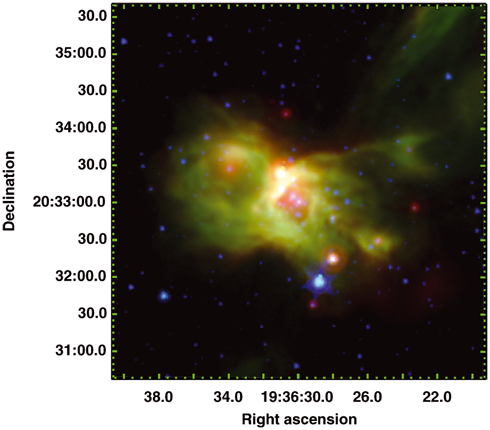The sequence of low- and high-mass star formation in the young stellar cluster IRAS 19343+2026,
Monthly Notices of the Royal Astronomical Society, Volume 407, pp. 1807 (2010)
BVRIJHK photometry, Spitzer-GLIMPSE photometry and HK-band spectroscopy were used to study the stellar content of IRAS 19343+2026, a (proto)star/cluster candidate, located close to the Galactic plane. The data suggest that IRAS 19343+2026 is a rich cluster associated with a massive protostar of 7.6 M☉ with an age of ~ 105 yr. Three point sources in the vicinity of the far-infrared (FIR) peak are also found to be early B type stars. The remaining (predominantly low mass) members of the cluster are best represented by a 1 - 3 Myr pre-main-sequence (PMS) population. HK-band spectra of two bright and five faint point sources in the cluster confirm that the results obtained from the photometry are good representations of their young stellar object (YSO) nature. Thus, IRAS 19343+2026 is a young cluster with at least four early B-type stars classified as young (104 - 105 yr), that are surrounded by a somewhat older (1 - 3 Myr) population of low mass YSOs. Together, these results argue for a scenario in which low mass stars form prior to massive stars in a cluster forming environment. We compute the Initial Mass Function (IMF) for this cluster using the K-band luminosity function; the slope of the IMF is shallower than predicted by the Salpeter's mass function. The cluster mass, Mtotal, is estimated to be in the range ~ 307 M☉ (from the data completeness limit) - 585 M☉ (extrapolated down to the brown dwarf limit, assuming a certain IMF).

Figure 1 | Three-colour composite of IRAS 19343+2026 made from Spitzer images. The MIPS 24µm, IRAC Ch4 (8.0µm) and IRAC Ch1 (3.6µm) images are coded red, green and blue, respectively. The abscissa and the ordinate are in J2000.0 epoch.
The sequence of the formation of the low- and high-mass stars in star formation is still a matter of debate among astronomers. This sequence has significance in constraining theoretical scenarios of star-formation as it is an outcome of many star-formation simulations.
Previous studies on this subject concluded that, in targets located away from the Galactic mid-plane, at least one generation of stars had already formed around the high-mass protostellar candidates. However, similar studies for candidates in the Galactic mid-plane failed to find such clustering. In order to understand if this dichotomy is a real feature or not, we used high-quality infrared and visible photometric and spectroscopic observations of IRAS 19343+2026, a high-mass protostellar object candidate located at 4.2 kpc. The observations were performed with the Spitzer Space Telescope, the United Kingdom Infrared Telescope and the Himalayan Chandra Telescope; data from the 2MASS survey was also used.
Figure 1, a color composite of 3 infrared images, using the 24micron and 8micron Spitzer images (coded red and green respectively) and the UKIRT 2micron image (coded blue), reveals the bipolar shape of the nebula. Although this feature is prominent in this figure due to excess emission in the far-infrared, a rich cluster of stars are seen in the near-infrared image at 2micron. The peak of the bipolar nebula seen in Fig.1 corresponds to three young massive stars.
By representing the detected stars on color-color and color-magnitude diagrams and fitting them to properly reddened (AV~8.0 mag) evolutionary tracks, we were able to determine that the low-mass population of this cluster has an age of about 1 Myr or less, although a group of sources with an age of about 3 Myr was also detected.
The initial mass function (IMF) of this cluster appears to rise monotonically up to ~1 M☉; it presents a slope of -1.21 ± 0.16, typical of ongoing star formation. The total cluster mass is estimated to be in the range 307 - 585 M☉.
Next, the three bright stars at the center of the cluster were modeled using Spectral Energy Distribution fitting, to conclude that they are massive stars of 6-7 M☉ with typical ages of 105 yr.
Therefore, the low mass population in this cluster was concluded to be far older than the massive stars even when considering the errors, which is the main conclusion of this paper.
The first observational evidences for the sequence of low and high mass star formation were presented by CAUP member Kumar in a few papers during 2004-2006. Most notably, Kumar, Keto & Clerkin, 2006, A&A, 449, 1033 (including Kumar and Clerkin, then CAUP members) presented the first systematic study of this sequence using 2MASS data. In this highlighted paper, Kumar and Grave have contributed significantly to the science analysis and in particular for the SED modeling and infrared spectra analysis. In fact, the PI of the observing proposal that obtained data for this proposal is also Kumar.

